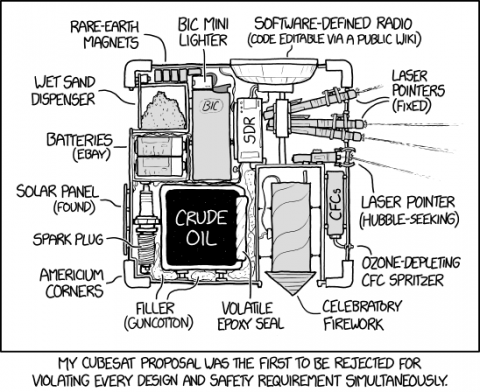Space (Policy) is Unforgiving
May 18, 2018Did you know there's a list of items you can't launch into space? You can't launch fuel, sealed containers, air, loose stuff, parts that can't handle a vacuum, or things in general that could cause damage. There are good reasons for such restrictions.
Space is hostile. A vacuum does not only mean no air to breathe, or no pressure. It also means that water, oil, and other liquids will evaporate, that materials will dry out and desiccate and maybe shatter, and that sealed pressure contains will pop. Sunlight is unfiltered, so space is alternately unforgivingly stove-hot at +120 C (240 F) in sunlight and colder than Antarctica at -120 C (-184 F) when the sun is blocked by the Earth. Plus, there's extra ultraviolet and X-ray radiation to mess up your electronics (or your DNA, should you venture there).
The rocket flight up adds in lots of thundering vibration and shaking and heavy G-forces squishing your payload. Rockets are giant towers of potentially explosive fuel built with a minimum of metal to protect them, because extra metal would make the rocket heavier and require more fuel. So they are a balance between the minimum needed to get the job done, with just enough safety margin to make them likely to succeed.
Our payloads can't have pressure vessels containing gases or liquids, because they are likely to rupture during launch or upon arrival into vacuum and contaminate and/or damage the rocket. Even some ordinary electronics like capacitors are problematic in space. Loose materials, breakable materials, or flammable materials are obviously right out.
Sadly, that means propellant systems for moving your CubeSat -- like compressed air or fueled thrusters -- aren't allowed. A 'Do No Harm' mission like our Cactus-1 CubeSat is guided by the need to minimize risk to other payloads, or to the rocket, should the satellite break upon launch. CubeSats must be low risk because they are 'ride along' payloads on rockets hoisting larger commercial, military, or scientific payloads.
"Safety Sat," pictured in the xkcd.com comic above, will never fly. Folks at NASA, however, have pitched a plan to allow scientifically-valid flights of 'risky' materials like liquids and pressure containers. The idea is to have a CubeSat-only rocket, with no larger Class-A or Class-B payload to endanger. It's all CubeSats, all the way.
Rocket science has the reputation of being hard. That isn't because it's technically more difficult compared to other engineering fields -- it isn't. What makes rocket science different is the degree of precision needed. It has to work with first time, with no tweaks or repairs after you launch. Ingenuity is often required to get around the difficulties involved in sending machinery into space. Often, it is also needed in order to navigate another set of challenges: namely, the constraints of space policy.
By Sandy Antunes, Associate Professor, Capitol Technology University



